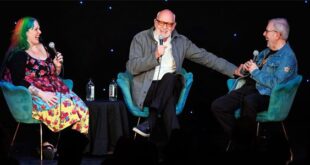Hollywood Hellraisers concerns the lives of four iconic movie stars; Marlon Brando, Dennis Hopper, Warren Beatty, and Jack Nicholson. Two of them are still with us, two are gone – but all left an indelible mark on Hollywood.
The book is basically a four-part biography. Each of the men started out poor, but developed a keen interest in acting early on. Marlon Brando was born April 3, 1924 in Omaha, Nebraska. His was an abusive, alcoholic family, and he left it behind at the age of 19. Four years later, on December 3, 1947 to be exact – Marlon Brando became a star. His role as Stanley Kowalski in A Streetcar Named Desire became the hottest ticket on Broadway.
Dennis Hopper came into the world on May 17, 1936, on a wheat farm in Kansas. He was only five when he lost his father during basic training before shipping out to join the war. In 1946, his father returned from the dead. Jay Hopper had been recruited as a spy, and his whole death had been a ruse. The entire event haunted Hopper until the day of his own death, and may in large part explain some of the self-destructiveness he later displayed.
Warren Beatty arrived in the world March 30, 1937 – three years after his sister Shirley MacLaine. They had a pretty normal upbringing in Richmond, Virginia, although both had their eyes on show business. Warren was still in high school when Shirley hit the big time. Sibling rivalry demanded that he become a bigger star.
Jack Nicholson was born (appropriately enough) in Neptune, New Jersey, on April 22, 1937. His situation is the strangest of the four, as he did not find out until the age of 38 that the woman he thought was his mother was actually his grandmother. And his “sister” had actually been his birth mother. Nicholson was already a rich and famous movie star by the time of the discovery, and acted unfazed by the whole thing. But it must have been devastating, especially as both had already passed away.
From these beginnings, the four Hollywood hellraisers conquered the world of film, each taking their own path. After brilliant performances in The Wild One (1953) and On The Waterfront, (1954) Marlon Brando perversely took on the worst roles imaginable – for the money. He was box-office poison for most of the sixties, and the studios would not touch him. Francis Ford Coppola had to convince Paramount to take a flyer on him for The Godfather (1972). Yet Brando came up with one of the most unforgettable characterizations ever, and won an Oscar for his role as Don Corleone.
Wild man Dennis Hopper’s self-destructive urges derailed his career practically before it began. Landing a bit part in Rebel Without A Cause, (1955) Hopper became enamored of James Dean. Unfortunately for Dennis, Dean had a bit of an attitude towards “the suits,” which he emulated for years.
Although Peter Fonda came up with the original kernel of Easy Rider (1969), even he agrees that it was really Hopper’s picture. The film’s profits changed the thinking in Hollywood virtually overnight, and ushered in a short-lived, but golden renaissance period. Without Easy Rider, directors such as Scorsese, Coppola, Lucas, and even Spielberg would have had a much tougher go of it.
Thanks to his habits, Dennis Hopper would not share in any of this. Although he enjoyed a celebrated role as the photographer in Apocalypse Now (1979), Hopper’s career did not really resume until Blue Velvet (1986). By then he had finally embraced sobriety. When he died in 2010, he had managed to rehabilitate his life and career – and after an incredible journey, was deservedly eulogized as a legend.
Jack Nicholson had been banging around in Hollywood for years before his big break. He worked in various capacities with Roger Corman throughout most of the sixties, until the call came for him to play the lawyer in Easy Rider. It made him a star, and enabled him to make such classics as Chinatown (1974), One Flew Over The Cuckoo’s Nest (1975), and The Shining (1980). While Nicholson has made his fair share of duds, and his personal life has occasionally come under scrutiny, he seems to be well-adjusted to life as a movie star.
As author Robert Sellers shows us, Warren Beatty has never been remotely self-destructive. In fact, he has proven to be one of the shrewdest businessmen in Hollywood. Early on, the pretty-boy landed some television roles, most notably in The Many Loves Of Dobie Gillis, but it wasn’t until Bonnie And Clyde (1967) that he became a household name.
Beatty’s drug of choice was sex, and his chapters in Hollywood Hellraisers are not much more than laundry lists of the women he has had. He made some memorable movies after Bonnie And Clyde, including Shampoo (1975), and Reds (1981). After decades of (as the British author puts it) “shagging,” Warren Beatty finally married Annette Bening in 1992. Upon the news, The Washington Post asked “Is this the end of civilization as we know it?” The rest of us just yawned.
Still, like the other three subjects of Hollywood Hellraisers, Warren Beatty has reached iconic status. This is a breezy read about four fascinating characters, and contains some intriguing, little-known stories. It is definitely worth a look for fans of the actors, or the movies in general.
 Blogcritics The critical lens on today's culture & entertainment
Blogcritics The critical lens on today's culture & entertainment



